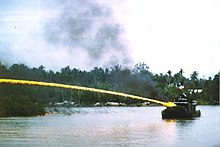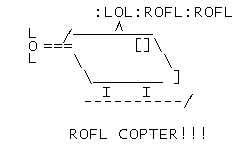Napalm
From Wikipedia, the free encyclopedia
For other uses, see Napalm (disambiguation).
Napalm is a mixture of a thickening/gelling agent and petroleum or a similar fuel for use in an incendiary device. It was initially used against buildings, and later was used primarily as an anti-personnel weapon that sticks to skin and causes severe burns when on fire. Napalm was developed in 1942, in a secret laboratory at Harvard University in Massachusetts, by a team led by chemist Louis Fieser.[1]Its first recorded use was in the European theatre of war during World War II; it was used extensively in incendiary attacks on Japanese cities in the Pacific War.
"Napalm" is a combination of the names of two of the constituents of the gelling agent: naphthenic acid and palmitic acid. "Napalm B" is the more modern version of napalm and, although distinctly different in its chemical composition, it is often referred to simply as "napalm".[2]
Contents
[hide]Forms[edit]
Napalm B is chemically distinct from its predecessor Napalm. It is usually a mixture of polystyrene and benzene, used as a thickening agent to make jellied gasoline. One of the advantages of this new mixture lies in its increased safety while being handled and stored. Many accidents had been attributed to personnel smoking around stockpiles.[3]
Napalm B has a commonly quoted composition of 21% benzene, 33% gasoline (itself containing between 1% and 4% (estimated) benzene to raise its octane number), and 46%polystyrene. This mixture is more difficult to ignite than napalm.[4] A reliable pyrotechnic initiator, often based on thermite (for ordinary napalm) or white phosphorus (for newer compositions), has been used.[2][4] The original napalm usually burned for 15 to 30 seconds while Napalm B can burn for up to 10 minutes.[4]
Napalm was used in flamethrowers and bombs by U.S. and Allied forces in World War II. It is believed to be formulated to burn at a specified rate and to adhere to surfaces to increase its stopping power. During combustion, Napalm rapidly deoxygenates the available air and generates large amounts of carbon monoxide and carbon dioxide. Napalm bombs were used during the Vietnam War.[2]
Napalm was also used during the Korean War, most notably during the defense of "Outpost Harry" in South Korea during the night of June 10–11, 1953[citation needed].
Alternative compositions exist for different uses, e.g. triethylaluminium, a pyrophoric compound that aids ignition.
Development[edit]
Use of fire in warfare has a long history. Greek fire, also described as "sticky fire" (πῦρ κολλητικόν) is believed to have had a petroleum base. The development of napalm was precipitated by the use of jellied gasoline mixtures by the Allied forces during World War II.[2] The supply of latex that had been used in these early forms of incendiary devicesbecame scarce during the Pacific Theater of Operations, since natural rubber was almost impossible to obtain after the capture by the Japanese army of the rubber plantations inMalaya, Indonesia, Vietnam, and Thailand.
This shortage of natural rubber prompted the chemists at U.S. companies such as Du Pont and Standard Oil, and researchers at Harvard University, to strive to develop factory-made alternatives - artificial rubber for all uses, including vehicle tires, tank tracks, gaskets, hoses, medical supplies and rain clothing. A team of chemists led by Louis Fieser at Harvard University was the first one to develop synthetic napalm, during 1942 for the U.S. Armed Forces.[5] "The production of napalm was first entrusted to Nuodex Products, and by the middle of April 1942 they had developed a brown, dry powder that was not sticky by itself, but when mixed with gasoline turned into an extremely sticky and flammable substance." One of Fieser's colleagues suggested adding phosphorus to the mix which increased the "ability to penetrate deeply...into the musculature, where it would continue to burn day after day."[6]
On 4 July 1942, the first test occurred on the football field near the Harvard Business school.[6] Tests under operational conditions were carried out at Jefferson Proving Ground on condemned farm buildings, and subsequently at Dugway Proving Ground on buildings designed and constructed to represent those to be found in German and Japanese towns,[7][8]this new mixture of chemicals was widely used in the Second World War in incendiary bombs and in flame throwers.
From 1965 to 1969, the Dow Chemical Company manufactured napalm B for the American armed forces. After news reports of napalm B's deadly and disfiguring effects were published, Dow Chemical experienced some boycotts of all its products, and its recruiters for new chemists, chemical engineers, etc., graduating from college were subject to campus boycotts. The management of the Dow Chemical Company decided that "its first obligation was the government." Meanwhile, napalm B became a symbol for the Vietnam War.[9]
Military use[edit]
Napalm was first employed in incendiary bombs and went on to be used as fuel for flamethrowers.[10]
The first recorded strategic use of napalm incendiary bombs occurred in an attack by the USAAF on Berlin on 6 March 1944, using American AN-M76 incendiary bombs (with PT-1 (Pyrogel) filler).[11][12] The second known attack, this time a tactical operation by De Havilland D.H.98 Mosquito FB Mk.VIs of No. 140 Wing RAF, Second Tactical Air Force on 14 July 1944, also employed the AM-M76 incendiary in a reprisal attack on the 17th SS Panzergrenadier Division „Götz von Berlichingen“ in Bonneuil-Matours; soldiers of thisWaffen SS unit had captured and then murdered a British SAS prisoner-of-war, Lt. Tomos Stephens, taking part in Operation Bulbasket, and seven local Resistance fighters; although it was not known at the time of the air strike, 31 other POWs from the same SAS unit, and an American airman who had joined up with the SAS unit, had also been executed.[13]
Further use of napalm by American forces occurred in the Pacific Theater of Operations, where in 1944 and 1945, napalm was used as a tactical weapon against Japanese bunkers, pillboxes, tunnels, and other fortifications, especially on Saipan, Iwo Jima, the Philippines, and Okinawa, where deeply dug-in Japanese troops refused to surrender. Napalm bombs were dropped by aviators of the U.S. Navy, theUnited States Army Air Forces, and the U.S. Marine Corps in support of their ground troops.[14]
Then, when the U.S. Army Air Forces on the Marianas Islands ran out of conventional thermite incendiary bombs for its B-29 Superfortresses to drop on Japanese cities, its top commanders, such as General Curtis E. LeMay, turned to napalm bombs to continue its fire raids on the large Japanese cities.[15]
In the European Theater of Operations napalm was used by American forces[16] in the siege of La Rochelle in April 1945 against German soldiers (and inadvertently French civilians in Royan) - about two weeks before the end of the war.[17]
Napalm B was also used during the Greek Civil War between the Greek Army and Communist rebels. During the last year of this Civil War, 1949, the United States increased its military aid to the Greek Government by introducing a new weapon to finish off the war: napalm B. The first napalm attack in Greece took place on the mountain of Grammos, which was the stronghold of the Communist rebels.[citation needed]
Napalm B was also widely used by the United Nations military forces during the Korean War.[2] These Allied ground forces in Korea were frequently outnumbered, and greatly, by their Chinese and North Korean attackers, but the U.S. Air Force and the U.S. Navy naval aviators had control of the air over nearly all of the Korean Peninsula. Hence, close air support of the ground troops along the border between North Korea and South Korea was vital, and the American and other U.N. aviators turned to napalm B as an important weapon for defending against communist ground attacks.
Napalm B became an intrinsic element of U.S. military action during the Vietnam War; as forces increasingly employed its widespread tactical as well as psychological effects.[18] Reportedly about 388,000 tons of U.S. napalm bombs were dropped in the region between 1963 and 1973, compared to 32,357 tons used over three years in the Korean War, and 16,500 tons dropped on Japan in 1945.[1]
The US Air Force and US Navy used napalm with great effect against all kinds of targets to include troops, tanks, buildings, jungles, and even railroad tunnels. The effect was not always purely physical as napalm had psychological effects on the enemy as well.[citation needed]
Other uses include: by France during the First Indochina War (1946–1954), the Algerian War (1954–1962),[19] the Portuguese Colonial War (1961–1974), The Six-Day War by Israel (1967), in Nigeria (1969), India and Pakistan (1965 and 1971), Turkey (1974), by Morocco during the Western Sahara War (1975–1991), Iran (1980–88), Brazil (1972), Egypt (1973), Iraq (1980–88, 1991), Angola (1993), Yugoslavia (1991-1996), and by Argentina (1982).[2][20]
Effects on people[edit]
When used as a part of an incendiary weapon, napalm can cause severe burns (ranging from superficial to subdermal) to the skin and body, asphyxiation, unconsciousness, and death. In this implementation, napalm fires can create an atmosphere of greater than 20%carbon monoxide[2] and firestorms with self-perpetuating winds of up to 70 miles per hour (110 km/h).
One of the main anti-personnel features of napalm is that it sticks to human skin, with no practical method for removal of the burning substance.[citation needed]
Napalm is effective against dug-in enemy personnel. The burning incendiary composition flows into foxholes, trenches and bunkers, and drainage and irrigation ditches and other improvised troop shelters. Even people in undamaged shelters can be killed byhyperthermia/heat stroke, radiant heat, dehydration, suffocation, smoke exposure, or carbon monoxide poisoning. The firebombing raids on German cities, e.g. Dresden and Hamburg, frequently caused death by this mechanism.[4]
One firebomb released from a low-flying plane can damage an area of 2,500 square yards (2,100 m2).[4]
International law[edit]
International law does not prohibit the use of napalm or other incendiaries against military targets,[21] but use against civilian populations was banned by the United NationsConvention on Certain Conventional Weapons (CCW) in 1980.[22] Protocol III of the CCW restricts the use of all incendiary weapons, but a number of states have not acceded to all of the protocols of the CCW. According to the Stockholm International Peace Research Institute (SIPRI), states are considered a party to the convention, which entered into force as international law in December 1983, if they ratify at least two of the five protocols. The United States signed it almost three decades after the General Assembly adopted it, on January 21, 2009: President Barack Obama’s first full day in office. America’s ratification, however, is subject to a diplomatic reservation that says it can disregard the treaty at its discretion if doing so would save civilian lives.




